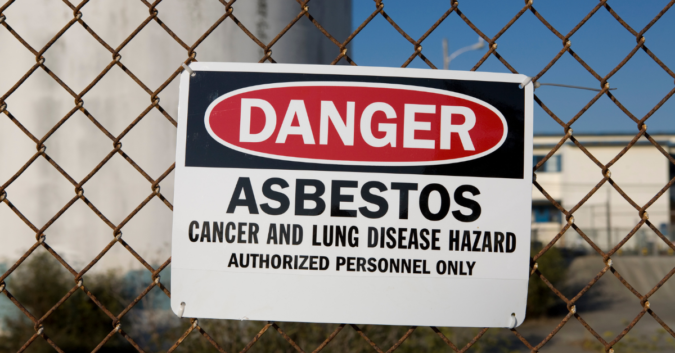Recently, the U.S. Environmental Protection Agency (EPA) proposed a rule that would ban the most common type of asbestos still in use in the United States. The agency’s timely announcement came on April 5, during Global Asbestos Awareness Week.
Due to the well-known facts regarding asbestos’s carcinogenic nature, many Americans believe that asbestos has already been banned. However, while the substance is banned in nearly 70 countries worldwide, it remains legal in the United States. Asbestos is the only known cause of mesothelioma — a fatal cancer with no cure.
Currently, chrysotile asbestos is still used in the creation of chlorine bleach and sodium oxide, as well as in the manufacturing of brake pads, diaphragms, sheet gaskets, and other products.
It’s Well Past Time for an Asbestos Ban in the U.S.
The EPA’s proposal results from the revised Toxic Substance Control Act (TSCA), which was overhauled in 2016, during then-President Obama’s second term. The law seeks to develop stronger safety regulations to govern thousands of toxic substances in the United States.
Back in 2016, during the bill’s signing ceremony, Obama described the current toxic chemical- and substance-safety laws as “so complex, so burdensome that our country hasn’t even been able to uphold a ban on asbestos. I think a lot of Americans would be shocked by all that.”
In an April press release, EPA Administrator Michael Regan noted the agency’s proposal is an important step in protecting public health, one that might “finally put an end to the use of dangerous asbestos in the United States.” Regan continued:
“[The proposed ban] demonstrates significant progress in our work to implement the 2016 law and take bold, long-overdue actions to protect those most vulnerable among us.”
According to data compiled by the Institute of Health Metrics and Evaluation (IHME), asbestos kills up to 40,000 Americans each year through diseases like mesothelioma and lung cancer.
A Ban Is an Important Step, But Much Work Remains
While the EPA’s proposal to ban chrysotile asbestos is certainly positive news and a landmark sign of progress, it remains to be seen if the agency can actually pass the proposal and make the ban official.
In addition, while the use and import of asbestos would be discontinued under the ban, so-called “legacy” asbestos could continue to be a problem for years to come. Given the abundance with which companies used asbestos for much of the 20th century, the substance remains lurking inside many old buildings, homes, and products.
A naturally occurring mineral prized for its heat- and fire-resistant properties, asbestos was hailed as a “miracle mineral” by manufacturers and was used to make thousands of products, including insulation, drywall, pipe wrap, floor tiles, roofing shingles, vehicle brakes, and much more.
Given the abundant use of asbestos over many decades, asbestos exposure remains a major hazard, as the following statistics show:
- The EPA estimates asbestos lingers in more than 700,000 public and commercial buildings in the United States, including 137,000 schools
- An estimated 1.3 million American workers are potentially exposed to asbestos at their job sites, according to the American Public Health Association (APHA)
- A study in the Journal of Toxicology and Environmental Health showed mesothelioma deaths in the United States have increased by 4.8% between 1999 and 2015
- Data from IHME shows more than 1 million Americans were killed by asbestos-related diseases between 1990 and 2019
- The U.S. Census Bureau estimates roughly 40% of all American housing units were built before 1970 and are highly likely to contain asbestos-containing building materials
Because the manufacturers of asbestos-containing products put profits ahead of people for generations, millions of Americans remain at risk of asbestos exposure. At particular risk are workers in certain high-risk occupations, who were — or are currently — exposed to asbestos on a regular basis, including those in the construction industry, firefighters, U.S. veterans, and many more.
Is Banning One Type of Asbestos Enough?
Sen. Jeff Merkley (D-OR), who recently introduced a Congressional bill that would ban new uses of asbestos, released a statement about the EPA’s proposed ban, saying:
“I’m glad to see the EPA making moves to ban asbestos, but the EPA process is very slow and they’re only addressing 1 of 6 recognized asbestos fibers. Meanwhile, Congress should immediately ban the importation and utilization of asbestos fibers in the manufacture of all products.”
In recent days, anti-asbestos advocates have echoed Merkley’s sentiments, saying the proposed ban does not go nearly far enough.
Asbestos Disease Awareness Organization (ADAO) Co-Founder and President Linda Reinstein noted the EPA’s proposal as “a landmark step forward,” but also said there remains much more work to be done. In an email statement to The Hill, Reinstein said, “[The EPA] did not propose to ban all six asbestos fibers, they only [proposed to] ban one fiber.”
The EPA’s proposal is open to public comment for 60 days. The Biden administration said it hopes to have the ban announced by November 2022. If the EPA’s proposal passes, companies that are still using asbestos as part of their manufacturing processes would have another two years to end the practice and find safer alternatives.
